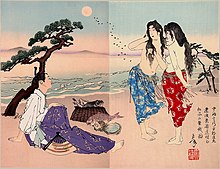Matsukaze
| Matsukaze | |
|---|---|
| 松風 | |
| English title | Wind in the Pines |
| Written by | Suma-ku, Kōbe |
| Time | Autumn — Ninth month |
| Sources | Kokinshū, Senshusho |

Matsukaze (松風, Wind in the Pines) is a play of the third category, the woman's mode, by Kan'ami, revised by Zeami Motokiyo. One of the most highly regarded of Noh plays, it is mentioned more than any other in Zeami's own writings,[1] and is depicted numerous times in the visual arts.
Plot
The two main characters are the lingering spirits of the sisters Matsukaze (Wind in the Pines) and Murasame (Autumn Rain), who in the 9th Century lived on the
The play opens with a traveling priest asking a local about a memorial he sees. The local explains that the memorial is to the two sisters. This is followed by a scene in which the sisters, ladling seawater into their brinecart at night, become fascinated by the sight of the moon in the water, and try to capture it.[4]
The priest dreams that he meets them when asking for lodgings. After revealing their identities, they explain their past, and grow overcome with their love and longing for Yukihira. Matsukaze, after donning the courtly hunting robe and hat left to her by the courtier, mistakes a pine for her love, and Murasame joins her briefly in madness,[5] before recovering, passing on from the mortal world of emotional attachment, and leaving her sister behind.
Sources and themes
The name of the chief character, and title of the play, Matsukaze, bears a poetic double meaning. Though Matsu can mean "pine tree" (松), it can also mean "to wait" or "to pine" (待つ). Matsukaze pines for the return of her courtier lover, like the woman of Akashi in the Genji, and like the woman in Zeami's play Izutsu. Tyler also draws a comparison between the names of the two sisters to a traditional element in Chinese poetry, referring to different strains of music as the Autumn Rain and the Wind in the Pines; Autumn Rain is strong and gentle intermittently, while the Wind in the Pines is soft and constant. Though the characters in the play actually represent the opposite traits – Matsukaze alternating between strong emotional outbursts and gentle quietness while her sister remains largely in the background, and acts as a mediating influence upon Matsukaze – the comparison is nevertheless a valid and interesting one.
Finally, Tyler offers the idea that the two women are aspects of a single psyche, or that they are "purified essences of human feeling... twin voices of the music of longing" [8] and not actually fully fleshed people.
Opera
Matsukaze became the subject of an opera by Japanese composer
See also
Notes
- ^ a b Tyler 1992, p. 183.
- ^ H Varley, Japanese Culture (2000) p. 117
- ^ H Varley, Japanese Culture (2000) p. 117
- ^ A Waley, The Noh Plays of Japan (1976) p. 205
- ^ T Hare, Zeami’s Style (1996) p. 176
- ^ A Waley, The Noh Plays of Japan (1976) p. 204
- ^ Goff 1991, p. 65.
- ^ Tyler 1992, p. 191.
- ^ Robin, William (4 August 2011). "Haunting Unpredictability". The New York Times. Retrieved 28 June 2018.
References
- Tyler, Royall (1992). Japanese Nō Dramas. London: Penguin Books. pp. 183–204.
- Goff, Janet Emily (1991). Noh Drama and "The Tale of the Genji": The Art of Allusion in Fifteen Classical Plays. Princeton University Press.
